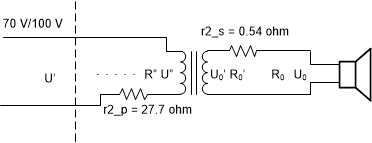SLAA898 September 2022 TAS3251 , TPA3255
4.1.3 Efficiency for Step-Down Transformer 330-040
 Figure 4-2 Equivalent System Circuit
Including DCR for Peavey® 330-040
Figure 4-2 Equivalent System Circuit
Including DCR for Peavey® 330-040Since the amplifier cannot generate a 70-VRMS signal to the 330-040, it is not easy to test the efficiency through experiment. According to Table 3-6, the DCR is relatively large for the step-down transformer. If only taking copper loss into consideration,
For the step down transformer:
According to Table 3-3 (configure 10 W as primary and 4 Ω as secondary):
As in the previous experiment, when using ten 4-Ω resistors configured as 10 W in Figure 3-5, the efficiency of the TPA3255 ηamp and step-up transformer ηup 18737 is 0.8 and 0.9 respectively (see Figure 4-1), so the system efficiency is about:
This is 0.08 higher than the test result because, in one case, the iron loss in the step-down transformer is not considered here. Conversely, as power goes up, the current in the transformer gets higher and higher, which reduces the turns ratio and equivalent resistance as a result. This makes the amplifier load below 4 Ω, and thus reduces the efficiency of the TPA3255 device to below 0.8.